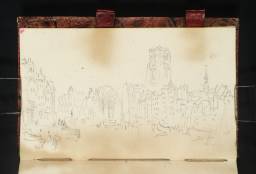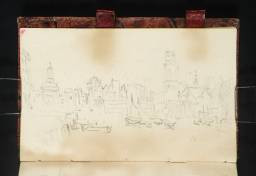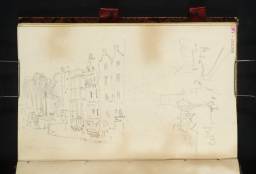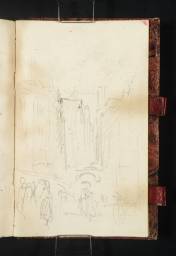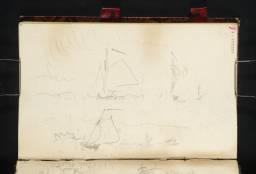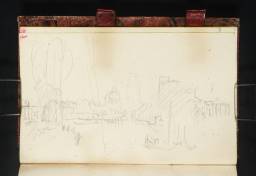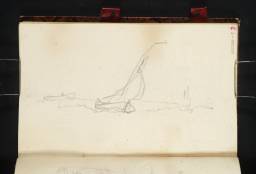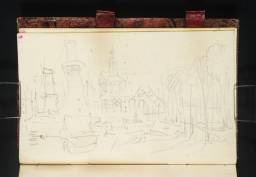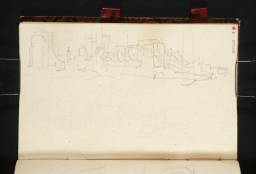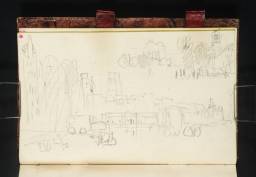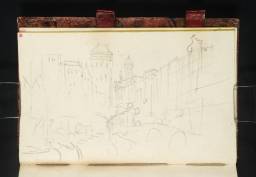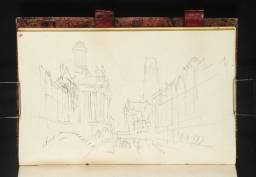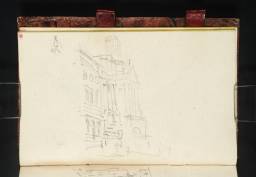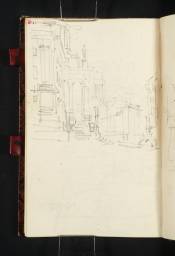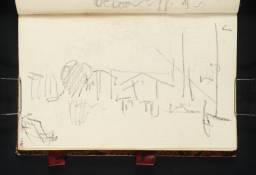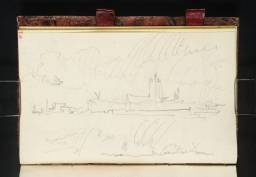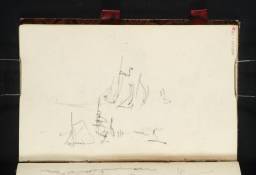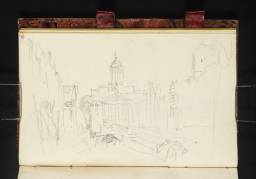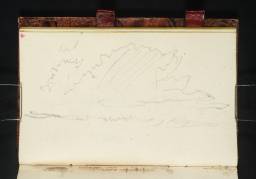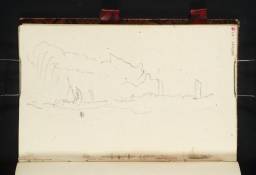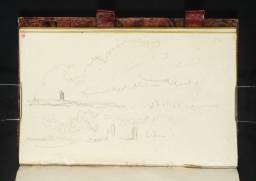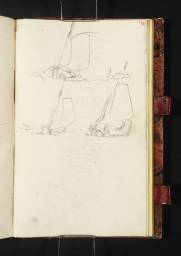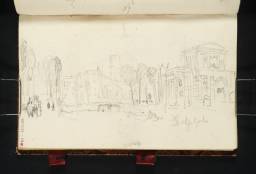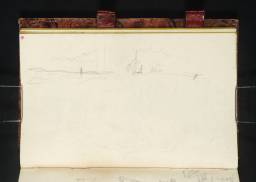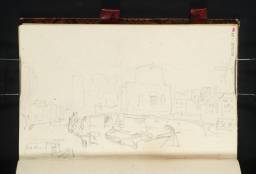CCCXXI 1–64
Sketchbook bound in boards covered with brown and orange marbled paper, with dark green and gold-tooled leather spine
Four loops of dark red leather (two attached to inside front cover and two to inside back cover) for holding pencils or fastening
Back cover has an inside pouch made from cream wove card, gussets made from vellum or parchment
Signed by H.S. Trimmer and Charles Turner in brown ink and inscribed ‘No 237 | 42 Leaves Containing | Pencil Sketches –’ at top of front cover pastedown
Signed in pencil by Charles Locke Eastlake ‘C.L.E.’ and John Prescott Knight ‘JPK’ towards centre of front cover pastedown
Blind Stamped with Turner Bequest monogram at centre of outside front cover and at top centre towards left of front cover pastedown
Stamped in black ‘CCCXXI’ top right front cover and at top centre towards left of front cover pastedown
Inscribed in pencil ‘CCCXXI’ at top centre towards right of front cover pastedown
64 leaves of off-white laid paper
Watermark present
Approximate size of page 153 x 95 mm
Four loops of dark red leather (two attached to inside front cover and two to inside back cover) for holding pencils or fastening
Back cover has an inside pouch made from cream wove card, gussets made from vellum or parchment
Signed by H.S. Trimmer and Charles Turner in brown ink and inscribed ‘No 237 | 42 Leaves Containing | Pencil Sketches –’ at top of front cover pastedown
Signed in pencil by Charles Locke Eastlake ‘C.L.E.’ and John Prescott Knight ‘JPK’ towards centre of front cover pastedown
Blind Stamped with Turner Bequest monogram at centre of outside front cover and at top centre towards left of front cover pastedown
Stamped in black ‘CCCXXI’ top right front cover and at top centre towards left of front cover pastedown
Inscribed in pencil ‘CCCXXI’ at top centre towards right of front cover pastedown
64 leaves of off-white laid paper
Watermark present
Approximate size of page 153 x 95 mm
Accepted by the nation as part of the Turner Bequest 1856
Exhibition history
References
For several decades scholars placed Turner’s Rotterdam sketchbook between 1837 and 1841: the date range provided by A.J. Finberg in his 1909 Inventory.1 Fred Bachrach later suggested the sketchbook was used on Turner’s tour to Switzerland in August 1841, as the artist usually accessed the Continent via the ports at Rotterdam or Ostend.2 In 1995, however, the culmination of extensive research for Turner in Germany led Cecilia Powell to establish that the sketchbook in fact belonged to an earlier 1835 tour of Northern Germany, the Elbe and Prague.3 It was used at the end of this tour, just before Turner returned to London, and is the last sketchbook in a series of six.
Turner first visited Rotterdam in 1817 and was there again in1825 (see the Dort and Holland sketchbooks, Turner Bequest CLXII and CCXIV). The port had strong associations with an artist he greatly admired: the Dutch marine painter Willem van de Velde (1633–1707). It also offered a variety of sketching opportunities, from quayside and canal scenes to delta views, where ships from across Europe would dock. By 1835 the city boasted a new town hall and St Dominicus’ church, as well as established markets, old churches and harbours. Of the sketches Turner produced in Rotterdam, one depicting the Leuvehaven fish market (Tate D32453; Turner Bequest CCCXXI 5a) led to a design for William Floyd’s engraving project, the Gallery of Modern British Artists (published 1836; see Tate impression T05150).
Technical notes
How to cite
Alice Rylance-Watson, ‘Rotterdam sketchbook 1835’, sketchbook, October 2016, in David Blayney Brown (ed.), J.M.W. Turner: Sketchbooks, Drawings and Watercolours, Tate Research Publication, August 2017, https://www


